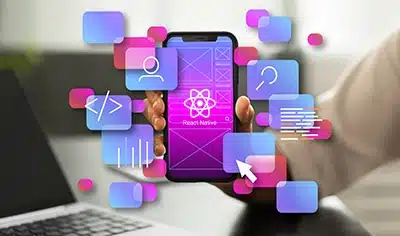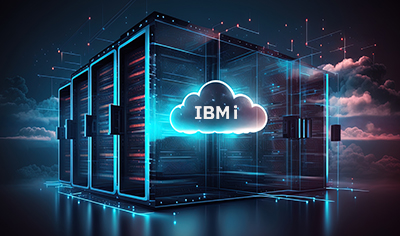Ever wonder why your earliest customers are also the first to leave your app? Or why does user engagement drop month after month? Why does your sales team struggle to attract new prospects?
Your legacy applications might be the reason. While you’re struggling to bridge security gaps and resolve integration issues, your competitors are probably building applications that are modern, intelligent, and autonomous.
Chances are that your app may lack the AI-powered capabilities that make applications more adaptive, predictive, and responsive. And in the current market where AI powers almost every interaction, this gap can quietly put you at a disadvantage.
But here’s the thing… transforming your legacy apps into intelligent, AI-infused applications isn’t as challenging as you might think. And you don’t even need to rip everything out and start from scratch. You just need the right approach to make your applications truly intelligent.
In this guide, you’ll discover the five characteristics that define intelligent applications, learn how to evaluate whether your current systems can close the gap, and get a clear roadmap for modernization that actually works. By the end, you’ll know exactly which modernization approach is best suited for your situation and how to prioritize your efforts for maximum impact.
Realizing the Legacy App Crisis and the Shift Toward Intelligent Apps
Your legacy applications do not fit well in the current scenario. Here’s what’s really happening in the background:
Technical debt is compounding daily. Every workaround, every patch, every “quick fix” has created a web of dependencies that makes even simple changes feel like defusing a bomb. You’re spending more time maintaining the system than improving it.
Security vulnerabilities are multiplying fast. Legacy systems weren’t built with today’s threat landscape in mind. You’re playing defense with outdated armor, and the gaps are widening.
Integration challenges are impacting your data flow. Your application data might be living in silos and have inconsistent formats. Getting data from point A to point B requires custom middleware that breaks almost every time.
Performance bottlenecks are frustrating users and limiting growth. Your applications can’t scale with demand. They often lag under pressure exactly when you need them to perform. The lack of AI capabilities doesn’t help either.
User experience gaps are driving customers away. Your interfaces feel like they’re from 2010 because, well, they probably are. With almost every business leveraging AI for personalization, it’s only normal that users now expect the same level of personalization and responsiveness from every app they use. And they’ll not settle for anything less.
Now, most organizations try to solve these problems with traditional modernization approaches, but they’re missing the point entirely.
1. Lift-and-shift limitations mean you’re just moving problems to the cloud. Sure, you might improve performance and reduce some maintenance overhead, but you’re still running the same inflexible, unintelligent applications—they’re just running somewhere else now.
2. Lack of intelligence integration keeps you in the dark space. Traditional modernization majorly focuses on infrastructure and performance but ignores the fundamental shift toward AI-driven capabilities. You may end up with faster legacy apps, but not necessarily intelligent ones.
3. The importance of complete transformation cannot be overstated. Half-measures don’t work anymore. You can’t just infuse AI into your legacy system and expect magic. Intelligence needs to be embedded into the very fabric of how your application operates at the core.
So, what exactly are intelligent apps?
What Are Intelligent Applications?
Intelligent apps primarily have built-in AI capabilities. These apps learn from both historical and real-time data and are known for making autonomous decisions. This means increased satisfaction, adoption, and productivity.
What really sets them apart is how they work with AI services. These services can completely change how the app behaves depending on the context. And do so, automatically. Also, intelligent apps rely on modern backend systems where services are easy to find and combine (think “plug and play”), and data is made easily accessible through what’s called a data fabric. If your backend isn’t set up this way, it’ll be hard for even the top AI solutions to function smoothly.
AI agents represent another new development. These are AI-led software bots that act like digital labors. They can analyze what’s happening, make decisions autonomously, and take actions. They can themselves be intelligent applications or work inside one. Either way, they add a powerful layer of intelligence and automation to your app.
What Powers Intelligent Apps: The Five Foundational Elements
Knowing what makes an application truly intelligent is crucial for your modernization strategy. As per Gartner®, there are “five characteristics of intelligent applications that differentiate them from other applications, and these characteristics determine the modernization needs of legacy applications.”
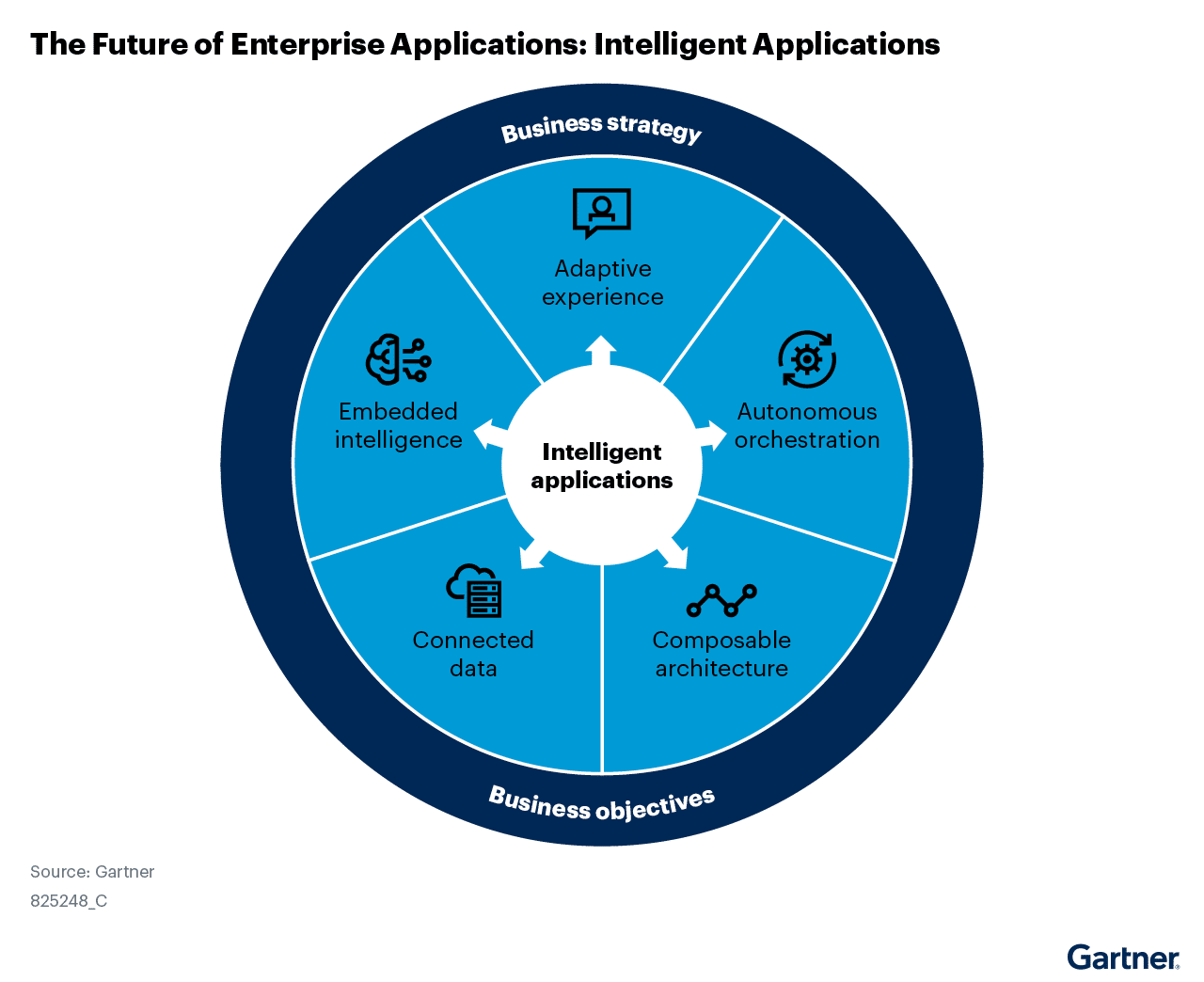
Now, here’s our perspective on these five characteristics.
1. Adaptive Experience
Your app’s user interface should tailor itself (or adapt) to each user in real time. Think dynamically changing workflows based on user behavior and showing only relevant information. Consider this… a user repeatedly skips through certain steps. The app learns and adapts to this specific behavior.
Ask yourself if your current UI can dynamically adapt based on user behavior and context. Or does everyone see the same interface regardless of their needs?
2. Embedded Intelligence
We strongly believe this is where most legacy applications fail. Most companies perceive AI to be something that they can add on top of their existing application. However, the fact is… it needs to be infused into every process from the ground up. For instance, intelligent applications offer analytics that don’t live in a separate dashboard (or system) that users have to navigate to. They are displayed inside the interface itself.
In contrast, legacy apps treat analytics as afterthoughts. Intelligent applications eliminate this friction by making intelligence a part of the natural flow (and not an additional layer on top).
3. Autonomous Orchestration
Your business processes should run themselves end-to-end, with minimal human intervention required for routine operations. This includes hyper-automation capabilities and higher forms of AI process standardization that can handle both structured data and unstructured data. The application should be able to adapt to changing conditions and handle exceptions intelligently and autonomously.
So, when your app faces an unwanted situation, here’s what it does… it understands the context, figures out the best possible action, and resolves the issue automatically. In highly complex cases, it can also escalate it to the concerned stakeholders.
4. Composable Architecture
Your services must be modular, reusable, interoperable, and accompanied by metadata that makes them discoverable. The idea is to infuse business capabilities that can be mixed and matched to create new experiences quickly. Each service includes rich metadata that describes what it does, how it works, and how it can be combined with the other services.
By making your services discoverable and reusable across different contexts, you can build new functionalities by composing existing capabilities rather than building everything from scratch.
5. Connected Data
You need a unified data ecosystem. In the case of intelligent apps, this is done via a data fabric that eliminates silos and supports real-time AI decisions. Your data flows freely across your organization through a fabric that provides consistent access, governance, and real-time processing capabilities. With this ecosystem, the AI embedded in your applications can access any data it needs to make intelligent decisions in real time.
How to Assess Your Exact Modernization Needs?
It’s important to understand here that each of your existing app components needs to be transformed to implement the five characteristics we talked about above. The following figure by Gartner shows the possible legacy modernizations required for each characteristic.
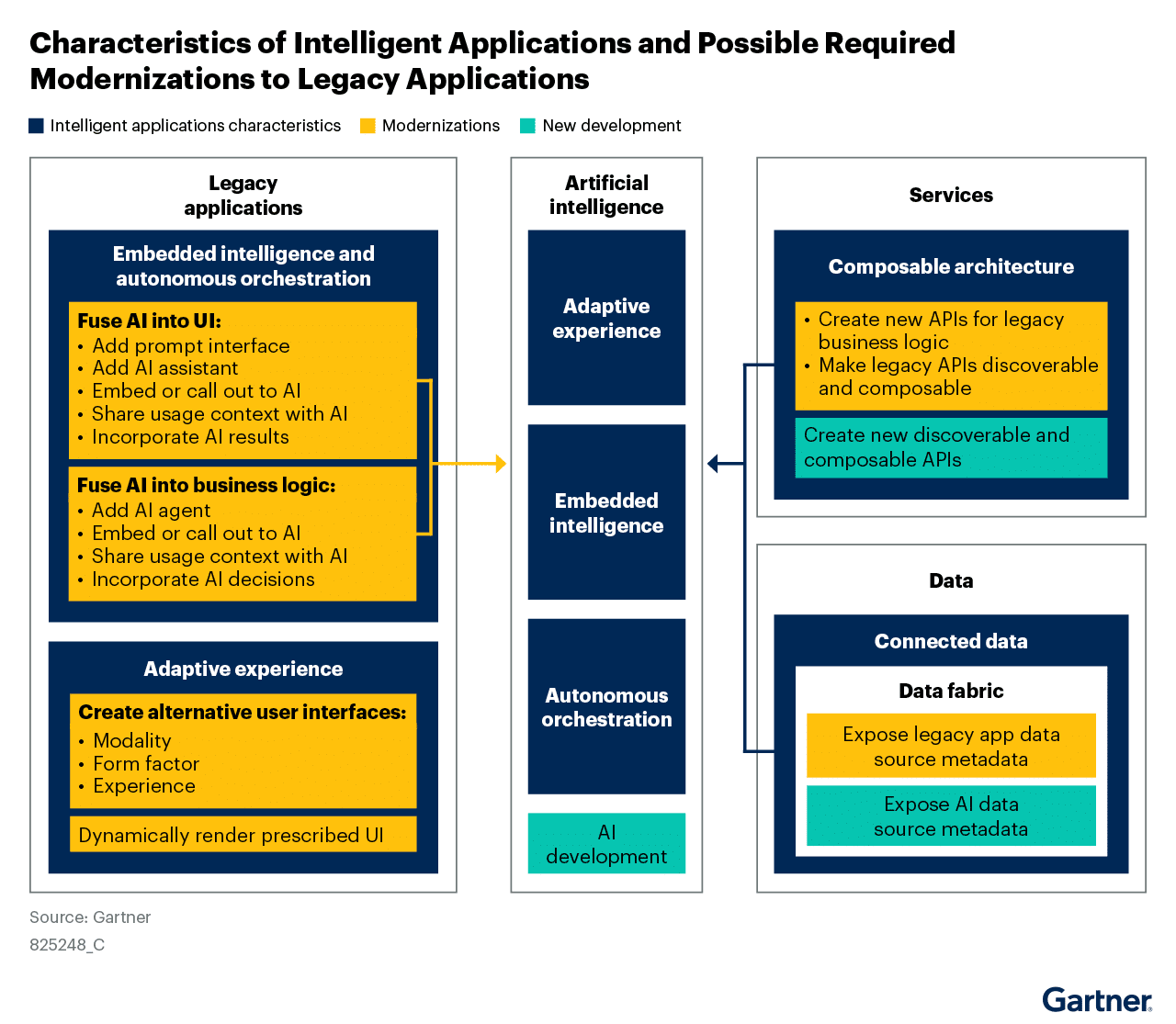
You need to honestly evaluate your current state versus the five intelligent app characteristics that you want to achieve. To make things easier, Gartner provides a questionnaire assessment. As Gartner says, “they will help you document why it isn’t possible to incorporate the five characteristics of intelligent applications into your existing applications.” Below, you’ll find the list of the questions in the questionnaire assessment and our take on each of them:
To Achieve Adaptive Experience
1. Can the existing UI technology support variations in form factor, modality and experience?
If your user interface is hardcoded for desktop browsers and can’t adapt to mobile devices, voice interfaces, or different user contexts, you need to work on your UI model first.
2. Can the existing UI technology receive and execute variation instructions?
Your interface needs to be programmable and responsive to instructions from AI services. If it’s static and inflexible, intelligence can’t be embedded effectively.
To Achieve Adaptive Experience, Embedded Intelligence & Autonomous Orchestration
3. Will the desired AI services be able to execute existing business logic as discoverable business services?
Your business logic needs to be accessible to AI systems. If it’s buried in monolithic applications with no API access, the AI can’t leverage your existing processes.
4. Can the existing UI technology interact with the desired AI services?
There needs to be a clear path for your user interface to communicate with AI services and display intelligent recommendations or automated actions.
5. Can the existing business logic technology interact with the desired AI services?
Your backend systems need to be able to send data to AI services and receive instructions back. Legacy systems with limited integration capabilities will struggle here.
To Achieve Composable Architecture
6. Are the existing business services composable?
If your business logic is tangled up in monolithic applications, you can’t easily combine different capabilities to create new intelligent workflows.
To Achieve Connected Data
7. Is the legacy application data currently exposed via a data fabric?
Without access to comprehensive, real-time data, AI services can’t make intelligent decisions. Data trapped in silos severely limits what’s possible.
If your answer is “No” for most of these questions, then you’ll need to modernize the components first. Now, let’s look at the possible modernization options you might have.
What Are Your Modernization Options?
As per Gartner, there are three standard modernization options for enterprises: Rearchitect, Rebuild, and Replace. Now, before you map your modernization options with the intelligent app characteristics you want to achieve, let’s take a step back and take a closer look at the modernization options. Here’s our interpretation of the three standard modernization options that Gartner suggests:
I. Rearchitect
This involves restructuring your existing applications to support the five characteristics of intelligent applications. You keep the core business logic but redesign the architecture to enable adaptive experiences, embedded intelligence, autonomous orchestration, composable services, and connected data.
II. Rebuild
Sometimes the technical debt is too deep, and you need to rebuild the application from scratch using modern technologies and intelligent application principles. You preserve the business requirements and user workflows but implement them with a completely new technical foundation.
III. Replace
This means selecting and implementing an intelligent application that meets your business needs. You’re essentially buying rather than building the intelligence capabilities you need. But this is often the fastest path to intelligence.
Evaluating Modernization Needs vs. Intelligent App Features You Wish to Achieve
Based on resources from Gartner, here’s our depiction of how you can map your modernization options with the intelligent app characteristics you want to achieve.
When modernizing for adaptive experience, organizations have two main routes. If rearchitecting, you might write alternative user interfaces using a different technology to suit various form factors, modalities, or experiences. You could also move UI components to a different application tier, making them more adaptable to AI-driven interactions, or rewrite them entirely with a technology better suited for dynamic adaptability. In a rebuild scenario, you could write alternative UIs using the same technology but for different devices or contexts or rewrite existing UI components to better support embedded AI interactions.
For embedded intelligence and autonomous orchestration, rearchitecting could involve moving UI components to a different application tier to embed AI interactions, rewriting them in a new technology, shifting existing business logic components to a different tier, or rewriting that business logic entirely for seamless AI integration. If rebuilding, you would focus on rewriting UI and business logic components… this time with the same underlying technology but optimized to work hand-in-hand with AI services.
When tackling composable architecture, a rearchitecture effort would expose embedded legacy business logic as discoverable and composable business services. Parallelly, a rebuild approach would involve rewriting existing business services entirely using composable architecture principles.
For connected data, rearchitecting means creating metadata for existing services so intelligent applications can autodiscover and autocompose them.
Finally, in cases where you want to achieve all the above characteristics, opt to replace existing application components altogether. Replace them with commercial solutions that already come equipped with intelligent capabilities, covering all five intelligent application characteristics in one go.
Here’s what Gartner suggests…
“Architect your modernizations using the principles of composability and buy, build, then blend to reduce your duration, cost and risk to the lowest practical level.”
Note that rehost and replatform options won’t work when your objective is to build intelligent apps. Here’s why. Rehosting (lift-and-shift) just moves your legacy problems to a new environment. Replatforming, on the other hand, might give you some cloud benefits, but you’ll still be running fundamentally unintelligent applications. These approaches might reduce infrastructure costs and improve performance, but they cannot make your legacy application intelligent.
Strategically Prioritizing Your Modernization Efforts
You can’t modernize everything at once, so prioritization is crucial. As Gartner recommends:
“Choose which intelligent applications characteristic work to prioritize either based on your AI business objective or based on your IT management approach.”
Based on this, here’s our view of how you can prioritize your modernization efforts:
Option 1: Based on Business Objectives
We believe that starting with the technology you want to implement is a little backward. You’ll probably end up with advanced technical capabilities that don’t solve your actual business problems. So, begin by identifying which business processes would benefit most from intelligence and then the characteristic required to deliver it. Here’s what Gartner suggests:
- a. If your goal is to improve operational efficiencies, you should focus on developing adaptive experiences and connected data capabilities. Together, these characteristics enhance data capture and streamline workflows, whether the work involves structured or unstructured processes.
- b. When your aim is to reduce operating costs, autonomous orchestration becomes the priority. By linking structured processes and minimizing the need for manual intervention, it significantly lowers reliance on users within workflows, leading to cost savings.
- c. To grow revenue, the emphasis should be on embedded intelligence. With advanced analytics built directly into the application, you can generate comprehensive insights that enable smarter business decisions and present fresh opportunities.
- d. If your objective is to modernize applications, prioritizing composable architecture is the way forward. It provides greater flexibility, scalability, and adaptability, enabling faster development and easier integration of new capabilities.
Option 2: Based on IT Management Style
Not every team is ready for aggressive AI-driven transformation. The key here is being honest about your organization’s readiness and choosing an approach that sets you up for success rather than overwhelming your team. Gartner recommends using the table below to “identify your typical IT management approach-pragmatic planner, fast follower or eager explorer.”
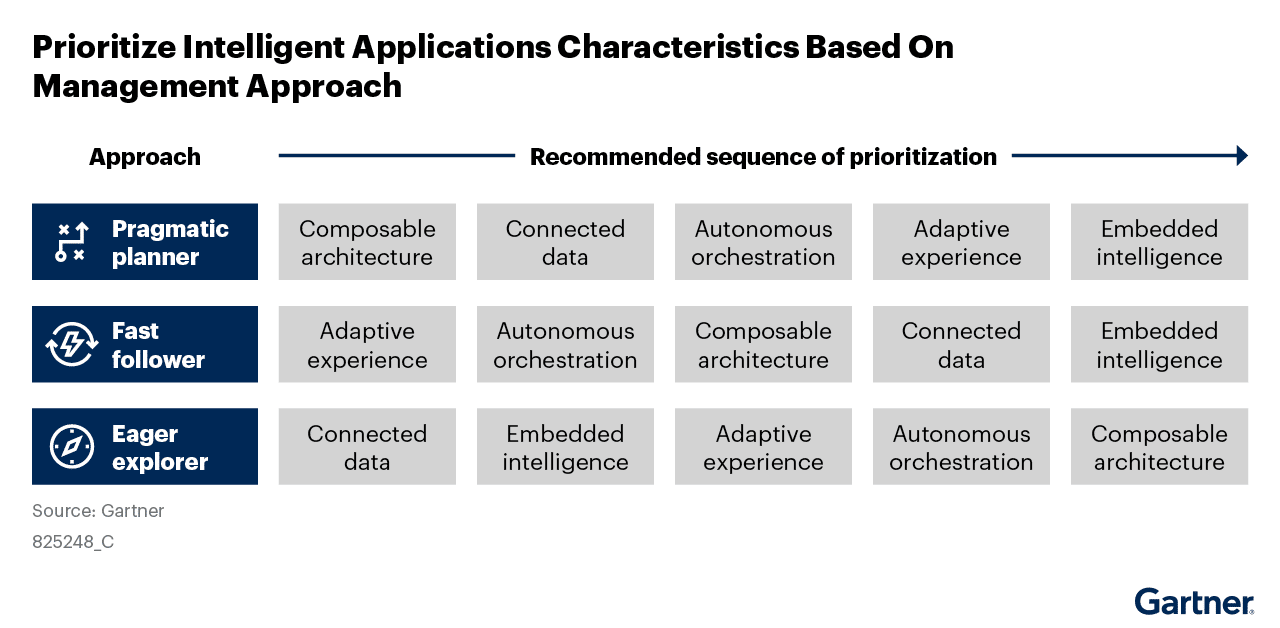
The concept of “bimodal” by Gartner involves managing two complementary ways of working. This is how we think Gartner defines each management approach can be defined:
- Pragmatic Planners: These organizations stick to tried-and-true technologies. They typically follow a traditional, step-by-step software development lifecycle (SFLC) that prioritizes reliability and accuracy.
- Fast Followers: These organizations selectively adopt new technologies. They move cautiously yet incorporate innovation into their existing frameworks.
- Eager Explorers: These organizations thrive on experimenting with and adopting the latest technologies. They are biased toward agility, rapid delivery, and the pursuit of new opportunities.
Quick Recap
Based on our discussion so far, modernizing legacy applications can be seen as a simple three-step approach:
Step 1: Assess Modernization Scope Using the 5 Characteristics
Evaluate your current applications against adaptive experience, embedded intelligence, autonomous orchestration, composable architecture, and connected data. This assessment will show you exactly what needs to change.
Step 2: Select the Right Modernization Method
Based on your assessment, choose to rearchitect, rebuild, or replace. Don’t waste time on approaches that won’t get you to intelligent applications.
Step 3: Prioritize Based on Your Goals or IT Style
Start with business-critical processes or choose applications that match your team’s capabilities and risk tolerance.
Go for a phased modernization for the best results. Start small, realize value, expand fast. You don’t need to transform everything simultaneously. Pick one application, make it intelligent, and use that success to fuel broader modernization efforts.
Each successful modernization builds your team’s capabilities and organizational confidence. The first intelligent application might be the hardest, but the second one will be faster, and the third will feel routine.
Your Next Move
The question isn’t whether to modernize your legacy applications-it’s how quickly you can start. Your competitors are building more intelligent, more adaptive, and more autonomous applications as you read this article.
Not sure where to start? Look at the most painful aspect of your app, the one that generates the most complaints from users or consumes the most manual effort. That’s probably your best candidate for intelligent application modernization. Consulting with an expert is one way to initiate the process. Your legacy applications got you here, but intelligent applications will take you where you need to be.
Gartner, How to Modernize Legacy Applications Into Intelligent Applications, By Graham Wilkins, Tad Travis, 7 May 2025
GARTNER is a registered trademark and service mark of Gartner, Inc. and/or its affiliates in the U.S. and internationally and is used herein with permission. All rights reserved.
This graphic was published by Gartner, Inc. as part of a larger research document and should be evaluated in the context of the entire document. The Gartner document is available upon request from Damco.




